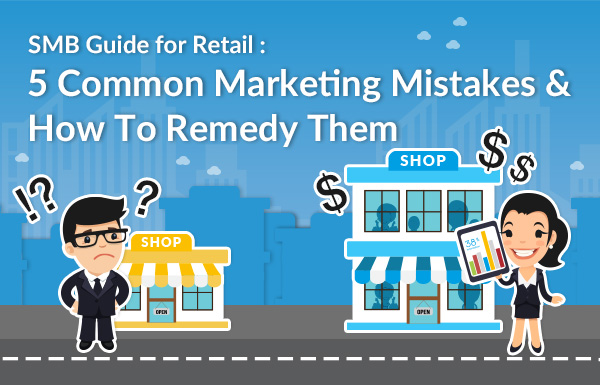
Marketing is no doubt the essential to a growing small retail business. However, if it’s not done well, it could take the business down.
Most small and middle-sized retailers are fighting to reach customers in very competitive markets, trying all marketing tactics. Your campaigns might not be expensive, but they could be wasting money and opportunities unless it is done well and integrated with the rest of the business.
Read on the 5 common mistakes. And here’re what you can do to stop wasting money and build marketing that empowers your sales team.
Your focus is to generate a lot of leads
Marketing activities aren’t just there to gather a great quantity of leads. If quality of leads is not the focus, your team may drown in leads that will never convert.
If you are just running a competition with a great prize that’s unrelated to your business’s offering, it may well gather lots of leads, but lots of those people aren’t even interested in buying your product or service – just winning the prize.
You would probably be better off with fewer leads that come from shoppers who are in your target market. That is, you need to know where your potential shoppers are and create ways that they can find you too – both online and offline. For example, offering practical, useful content discussing a trending topic relevant to your target market could make your campaigns targeted.
Mysterious shoppers pay and go
You have no data tracking where a shopper came from, nor do you know his/her buying habits and preferences. Understanding where a shopper came from can help you formulate the right marketing campaign to meet a particular targeted group of customers.
For example, if a shopper comes from a campaign offering a promotional discount, the prospect could be price-sensitive. If someone responds to a campaign about a particular product, this reveals his/her buying needs.
If you don’t know where a lead came from you’ll also be missing out on insights like:
- Did your shoppers have brand awareness or not?
- Were they in research or buying mode?
- Which channel is best to engage with them?
Start capturing and managing customer data in a CRM to build a 360-degree customer view and create targeted and precise marketing campaign.
Read more: Insight Article: SMB Guide on Evaluating and Implementing CRM
Poor Audience Segmentation
Once you get customer data sorted out, you can carry out audience segmentation to profile your potential customers and build different target market groups. Today’s shoppers expect a personalised experience. While there could be various levels of personalisation, it all starts with proper audience segmentation.
Even you have segmented your audience, you might not realise some of the most common mistakes that retailers make include:
- Segmentations are too general for any specific personalised message.
- Segmentation rules are too narrow so that the resulting audience is too small to generate any significant revenue
- Segmentations done right, but were matched with the wrong pitch
You lack a holistic engagement plan
Far too often, retailers send everything to everyone, without a strategic plan of engagement – What, When & Where of Messages.
Most marketing teams, due to scattered customer data, are unable to plan and build a personalised customer journey – where different messages are triggered to send out to the customer based on their stage in the buying journey. You miss out on the opportunity to have these targeted conversations with customers because you don’t have any way to measure and track where customers fall in the buying lifecycle.
Start your engagement plan by tracking and managing your customer data in a CRM. Once you have all data well-sorted, you can even automate and trigger instant messages based on a shopper’s response. Consider sending customers who have indicated they are almost ready to make a purchase different messages than those who are still just exploring. Try different levels of recommendations to trigger further interactions. Meanwhile, you should send a different set of messages to customers who have declining interests, say re-engage with them using discounts.
You are following industry leaders, not your business goals
What happens to most small and middle-sized retailers is that they are trying to do what their industry competitors are doing, instead of addressing the business goals from the sales team.
Although competitor monitoring is crucial, not all your competitors’ beautiful-looking campaigns apply to your business. Your efforts are in vain if you are creating nice-looking email campaigns which are unable to drive conversions.
Marketing needs to take its lead from sales. What does the sales team need help to achieve? What needs to be pushed, when and to whom?
Collaboration between sales and marketing is the key.
What really matters to shoppers, how they make their buying decisions and what makes your product or service stand out from the others available in the market – all these count into successful marketing campaigns. If you separate your marketing team from your sales operation then you’ll end up with beautiful marketing campaigns that aren’t focused on achieving the right goals.
Wait no more – Refine your strategies!
So, these are the 5 small changes to ensure that your marketing investment is paying off. Get your campaigns running right and see a big improvement in both marketing efficiencies and sales.
Want to make all of this simple? We’re here to help. Schedule a consultation with Introv today to share with us your challenges.
Read more: 5 Mistakes Made by SMBs When Evaluating a CRM for Their Business
Read more: Leverage Facebook Data for Peak Advertising ROI
About Introv
We are an award-winning, full service IT & Business Management Consultancy Service Provider in APAC. We offer best-in-class collaborative software solutions to companies of all sizes, looking to improve the operational excellence of their business.













